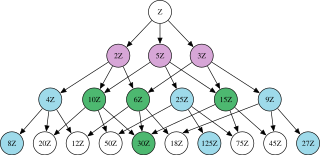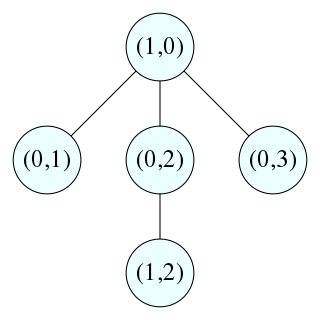
In algebra, a prime ideal is a subset of a ring that shares many important properties of a prime number in the ring of integers. The prime ideals for the integers are the sets that contain all the multiples of a given prime number, together with the zero ideal.
In commutative algebra, the Krull dimension of a commutative ring R, named after Wolfgang Krull, is the supremum of the lengths of all chains of prime ideals. The Krull dimension need not be finite even for a Noetherian ring. More generally the Krull dimension can be defined for modules over possibly non-commutative rings as the deviation of the poset of submodules.
In mathematics, a commutative ring is a ring in which the multiplication operation is commutative. The study of commutative rings is called commutative algebra. Complementarily, noncommutative algebra is the study of ring properties that are not specific to commutative rings. This distinction results from the high number of fundamental properties of commutative rings that do not extend to noncommutative rings.
In algebra, ring theory is the study of rings—algebraic structures in which addition and multiplication are defined and have similar properties to those operations defined for the integers. Ring theory studies the structure of rings, their representations, or, in different language, modules, special classes of rings, as well as an array of properties that proved to be of interest both within the theory itself and for its applications, such as homological properties and polynomial identities.
In mathematics, a Cohen–Macaulay ring is a commutative ring with some of the algebro-geometric properties of a smooth variety, such as local equidimensionality. Under mild assumptions, a local ring is Cohen–Macaulay exactly when it is a finitely generated free module over a regular local subring. Cohen–Macaulay rings play a central role in commutative algebra: they form a very broad class, and yet they are well understood in many ways.
In mathematics, in particular in the theory of schemes in algebraic geometry, a flat morphismf from a scheme X to a scheme Y is a morphism such that the induced map on every stalk is a flat map of rings, i.e.,
In algebraic geometry, a proper morphism between schemes is an analog of a proper map between complex analytic spaces.
In mathematics, coherent duality is any of a number of generalisations of Serre duality, applying to coherent sheaves, in algebraic geometry and complex manifold theory, as well as some aspects of commutative algebra that are part of the 'local' theory.
In algebraic geometry, an algebraic variety or scheme X is normal if it is normal at every point, meaning that the local ring at the point is an integrally closed domain. An affine variety X (understood to be irreducible) is normal if and only if the ring O(X) of regular functions on X is an integrally closed domain. A variety X over a field is normal if and only if every finite birational morphism from any variety Y to X is an isomorphism.
In mathematics, a GCD domain is an integral domain R with the property that any two elements have a greatest common divisor (GCD); i.e., there is a unique minimal principal ideal containing the ideal generated by two given elements. Equivalently, any two elements of R have a least common multiple (LCM).
In mathematics, specifically commutative algebra, a proper ideal Q of a commutative ring A is said to be primary if whenever xy is an element of Q then x or yn is also an element of Q, for some n > 0. For example, in the ring of integers Z, (pn) is a primary ideal if p is a prime number.
In mathematics, a band is a semigroup in which every element is idempotent. Bands were first studied and named by A. H. Clifford.
In commutative algebra, an element b of a commutative ring B is said to be integral over a subring A of B if b is a root of some monic polynomial over A.
In commutative algebra, a quasi-excellent ring is a Noetherian commutative ring that behaves well with respect to the operation of completion, and is called an excellent ring if it is also universally catenary. Excellent rings are one answer to the problem of finding a natural class of "well-behaved" rings containing most of the rings that occur in number theory and algebraic geometry. At one time it seemed that the class of Noetherian rings might be an answer to this problem, but Masayoshi Nagata and others found several strange counterexamples showing that in general Noetherian rings need not be well-behaved: for example, a normal Noetherian local ring need not be analytically normal.
In algebraic geometry, Zariski's main theorem, proved by Oscar Zariski, is a statement about the structure of birational morphisms stating roughly that there is only one branch at any normal point of a variety. It is the special case of Zariski's connectedness theorem when the two varieties are birational.
In abstract algebra, an associated prime of a module M over a ring R is a type of prime ideal of R that arises as an annihilator of a (prime) submodule of M. The set of associated primes is usually denoted by and sometimes called the assassin or assassinator of M.
In commutative algebra, an integrally closed domainA is an integral domain whose integral closure in its field of fractions is A itself. Spelled out, this means that if x is an element of the field of fractions of A that is a root of a monic polynomial with coefficients in A, then x is itself an element of A. Many well-studied domains are integrally closed, as shown by the following chain of class inclusions:
This is a glossary of algebraic geometry.
This is a glossary of commutative algebra.

In mathematics, and more specifically in combinatorial commutative algebra, a zero-divisor graph is an undirected graph representing the zero divisors of a commutative ring. It has elements of the ring as its vertices, and pairs of elements whose product is zero as its edges.








